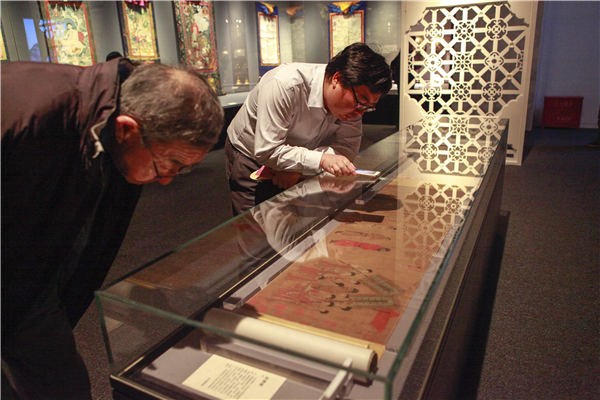Treasure trove from Tibet
Updated: 2018-03-01 By Wang Kaihao (China Daily)  Print
Print 



Visitors view Bunian Tu, a celebrated painting of the Tang Dynasty depicting Emperor Taizong receiving Tibetan envoy Gar Tongtsen Yulsung. [Photo provided to China Daily]
The rarely seen masterpiece Bunian Tu, also known as Emperor Taizong Receiving the Tibetan Envoy, is on show at an ongoing exhibition in Beijing.
There was an air of mystery about the Tibetan History and Culture exhibition at the Capital Museum in Beijing on Tuesday as the catalog of the event was not released until after its inauguration.
But it seems to have been worth the wait as a rarely seen masterpiece titled Bunian Tu, also known as Emperor Taizong Receiving the Tibetan Envoy, is on show at the event and will remain there for two months.
The 1.3-meter-long silk scroll is generally believed to have been painted by Yan Liben, an artist and official in the Tang Dynasty (618-907), but some scholars say it is a facsimile of Yan's work from the Northern Song Dynasty (960-1127).
"It's really a treasure," says Han Zhanming, director of the Capital Museum.
"The painting is one of the 10 most celebrated surviving paintings from ancient China," he says.
The work, now part of the collection of the Palace Museum in Beijing, reflects the close connections between the Tang court and Tibet, which was then the kingdom of Tubo.
In the painting based on a historical event, Emperor Taizong of the Tang Dynasty meets Gar Tongtsen Yulsung (also known as Lun Dongzan in historical records), who was then the envoy of the Tubo ruler Songtsen Gampo.
At that time, Songtsen Gampo proposed a marriage alliance with the royal family of Taizong.
Consequently, Princess Wencheng, a member of the Tang royal clan, was given in marriage to the Tubo ruler, a move which greatly enhanced the cultural and political ties between the two powers.
The masterpiece on show is one of the 216 cultural relics on display at the ongoing exhibition, which have been borrowed from 21 institutions nationwide, according to Han.
He says 90 percent of the exhibits are national-level precious cultural relics.
Many exhibits have been borrowed from sacred religious sites in the Tibet autonomous region, including the Jokhang Monastery in Lhasa; the Tashi Lhunpo Monastery and Sakya Monastery, both in Xigaze. None of the relics have been publicly displayed in a museum before.
Despite its reputation, the Bunian Tu has not overshadowed the other treasures on display.
Instead, it is like a guide ushering visitors into a show of Tibetan history and culture.
For example, a Qing Dynasty (1644-1911) thangka - Tibetan Buddhist painting on cotton or silk applique - records how Princess Wencheng entered Tibet and how the Jokhang Monastery was built following her arrival.








